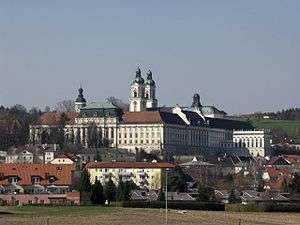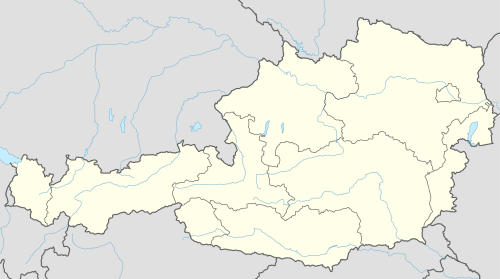Sankt Florian
| Sankt Florian | ||
|---|---|---|
 | ||
| ||
 Sankt Florian Location within Austria | ||
| Coordinates: 48°12′32″N 14°22′46″E / 48.20889°N 14.37944°ECoordinates: 48°12′32″N 14°22′46″E / 48.20889°N 14.37944°E | ||
| Country | Austria | |
| State | Upper Austria | |
| District | Linz-Land | |
| Government | ||
| • Mayor | Robert Franz Zeitlinger (ÖVP) | |
| Area | ||
| • Total | 44 km2 (17 sq mi) | |
| Elevation | 296 m (971 ft) | |
| Population (14 June 2016)[1] | ||
| • Total | 6,077 | |
| • Density | 140/km2 (360/sq mi) | |
| Time zone | CET (UTC+1) | |
| • Summer (DST) | CEST (UTC+2) | |
| Postal code | 4490 | |
| Area codes | 07224, 07223 | |
| Vehicle registration | LL | |
| Website | Official website | |
Sankt Florian is a town in the Austrian state of Upper Austria. It is 10 miles (16 km) from Linz.
St Florian's Priory and basilica
The town of Sankt Florian is the home of St Florian's Priory, a community of Canons Regular named after Saint Florian and one of the oldest operational monasteries in the world following the Rule of St Augustine. Composer Anton Bruckner (1824–96), who was a choirboy and later organist in the town, is buried beneath the organ inside the monastic church, which was elevated to the rank of basilica minor in 1999.[2]
St Florianer Sängerknaben
St Florian's is also known for its boys' choir (St Florianer Sängerknaben),[3] founded in 1071. The choir has been a traditional part of the monastery's worship from its beginning and has contributed significantly to the identity of the town. It has particular responsibility for providing excellence in sacred music for the religious community, but also undertakes successful international concert tours and television appearances.
Selected discography
- Franz Farnberger, Anton Bruckner in St Florian – Requiem & Motetten, St Florianer Sängerknaben - CD: Studio SM D2639 SM 44, 1997 (with Bruckner's Magnificat & Psalm 22)
- Gunar Letzbor, Joseph Balthasar Hochreither - Requiem; Missa Jubilus sacer. St Florianer Sängerknaben, Ars Antiqua Austria - CD: Pan Classics PC 10264, 2014
Museums
Sankt Florian has a fire fighting museum (Historisches Feuerwehrzeughaus; situated in a part of the monastic buildings), a hunting museum (Jagdmuseum Schloss Hohenbrunn)[4] and a museum of farming and local history (Sumerauerhof).
Population
| Historical population | ||
|---|---|---|
| Year | Pop. | ±% |
| 1869 | 3,631 | — |
| 1880 | 3,804 | +4.8% |
| 1890 | 3,700 | −2.7% |
| 1900 | 3,722 | +0.6% |
| 1910 | 3,714 | −0.2% |
| 1923 | 3,583 | −3.5% |
| 1934 | 3,613 | +0.8% |
| 1951 | 4,266 | +18.1% |
| 1961 | 3,709 | −13.1% |
| 1971 | 3,843 | +3.6% |
| 1981 | 4,129 | +7.4% |
| 1991 | 5,116 | +23.9% |
| 2001 | 5,530 | +8.1% |
| 2011 | 5,976 | +8.1% |
References
- ↑ Statistik Austria - Bevölkerung zu Jahresbeginn 2002-2016 nach Gemeinden, Erstellt am 14.06.2016 (Last accessed 13.12.2016) for Sankt Florian.
- ↑ Sankt Florian Monastery website, stift-st-florian.at; accessed 4 November 2016.(German)
- ↑ "Aktuelles". Florianer.at. 17 August 2016. Retrieved 4 November 2016.
- ↑ "Aeiou photo date image". Aeioue.at. Retrieved 4 November 2016.
External links
- Sankt Florian Monastery website
- Basilica of SS Florian and Augustine: the frescoed ceiling of the nave
- St Florian's Priory: the Kaiser's room
